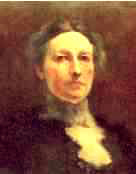
Lady Gregory
AE (George W. Russell)
Courtesy Abbey Theatre
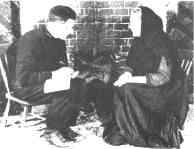
Peig Sayers dictating her story
to her son Micheál
Roinn Bhéaloideas Éireann
There are endless opportunities for women to be creative in their persons, homes, families, communities and employment, though few gained fame as artists in the past. They lacked access to training for the creative activities that were most celebrated and rewarded and much of their time was taken up with the creative activities of home-making and motherhood. As women were expected to be discreet and modest, many published their work anonymously or used male pen-names.
Nevertheless, Irish women writers made a considerable impact on the literary scene in the later modern period. Sydney Owenson, Lady Morgan helped romanticise Ireland with her novel, The wild Irish girl. Maria Edgeworth's first novel, Castle Rackrent, published anonymously in 1800 was an enduring success and influenced several important European novelists in the nineteenth century. Much of her work was humorous and satirised the landed gentry. Somerville and Ross, two women from a similar landed background expressed their amusement at Irish life in a different comic style at the end of the nineteenth century. Other women writers of the nineteenth century included Eva Kelly, Emily Lawless and Speranza (Lady Wilde). Lady Dufferin wrote well-known lyrics about the tragedy of emigration.
Writers at the turn of the century included Ethna Carbery, Alice Milligan, Eva Gore-Booth and Susan Mitchell.
| Simply the statement that there were in excess of five hundred Irish women writers during the nineteenth century should dispel the belief that women were silent. Anne Colman, 'Far from silent ...' in Margaret Kelleher & J.H. Murphy (eds.), Gender perspectives in nineteenth century Ireland, Dublin, 1997, p.203. |
Asenath Nicholson came to Ireland from the US to promote the Bible and as a relief worker during the Famine. She travelled around the country meeting a wide variety of people rich and poor and wrote a vivid account of her work and experiences here. Her books are important primary sources for the period because of her concern for justice, respect for the poor, independence of mind and strong character. Elizabeth Smith, wife of a landlord at Baltiboys House near Baltinglass, Co. Wicklow kept a journal during the years of the Famine. It too is an interesting source for the period, describing how a practical, sympathetic and conscientious woman of her class responded to the problems of tenants in the area. Anna Maria Hall wrote about her travels around Ireland before the Famine and Dervla Murphy described her travels by bicycle to remote foreign places in the twentieth century.
Lady Gregory was a leading figure in the Irish Literary Revival and wrote dramas for the Abbey Theatre. Katherine Tynan Hinkson was a popular and versatile writer of the same period and Annie M.P. Smithson wrote romantic novels which were best sellers in the early twentieth century.
 Lady Gregory AE (George W. Russell) Courtesy Abbey Theatre |
 Peig Sayers dictating her story to her son Micheál Roinn Bhéaloideas Éireann |
Elizabeth Bowen's short stories won her many honours and Mary Lavin became Ireland's best known female short story writer and encouraged young writers in Dublin. Both Kate O'Brien and Edna O'Brien wrote novels that questioned social and religious values of the mid twentieth century. Other successful and interesting women writers of fiction include Molly Keane, Maura Laverty, Julia O'Faoláin, Jennifer Johnston, Maeve Binchy Clare Boylan and Ita Daly.
Máire Bhuidhe Ní Laoghaire composed love poems in Irish and adapted the aisling form to treat of political affairs in the early nineteenth century. Peig Sayers described her experience as a woman on the Blasket Islands before that way of life disappeared. Máire Mhac an tSaoi expressed significant themes in Irish poetry and Nuala Ní Dhomhnaill wove Gaelic mythology and modern female consciousness into poetry in Munster Irish. Máiréad Ní Ghráda's Irish drama An Triail was an important landmark in the discourse about unmarried pregnancy in the 1960s.
Creative Irish women responded in different ways to the Women's Movement in the 1970s depending on their talents and inclinations. Eavan Boland found a poetic voice that evoked a response in other women to the many challenges facing women and men in the late twentieth century. So in their own individual ways did Rita Kelly, Leland Bardwell, Maeve Kelly, Rita Ann Higgins, Paula Meehan, Medbh McGuckian, Eiléan Ní Chuilleanáin, and a host of others.
Writing for children and young people demands special skills. Among the Irish women who have responded to the challenge are Maria Edgeworth, Sinéad de Valera, Patricia Lynch, Marita Conlon-McKenna, Eileen O'Faoláin, Eilís Dillon, Áine Ní Ghlinn, Marilyn Taylor, Morgan Llewellyn, Mary Arrigan and Siobhán Parkinson.
The dramas of Marie Jones and Marina Carr have been very successful and several women are involved in script-writing for film and television.
When three Dublin galleries held a major exhibition in 1987 of Irish women artists from the eighteenth century to the present day, their researchers identified over 200 women who had made worthwhile contributions to the arts in Ireland.
Women learned arts and crafts from male relatives or in private schools as part of the 'accomplishments' they were supposed to acquire for middle-class marriage. They were admitted to the schools of the Royal Dublin Society in 1849, but not to anatomy classes. Although a large number of females won prizes, they were not invited to the ceremonial prizegiving because,
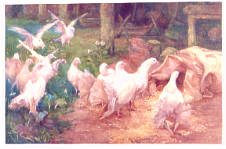 A preliminary investigation Mildred Anne Butler (1858-1941) |
... 'it has not been thought advisable to invite them to take part in this public display' on the grounds that it would be 'inconvenient and disagreeable' to them. Jeanne Sheehy in catalogue of Irish women artists from the eighteenth century to the present day, Dublin, 1987, p.9. |
| Women were not allowed into the schools of the then prestigious Royal Hibernian Academy until 1893. However the Watercolour Society of Ireland had women as executive members in the 1870s and the superb watercolours of Mildred Anne Butler and Rose Barton are to be found in important collections. |
|
The national movement in Ireland in the late nineteenth century coincided with a revival of applied and fine arts in Europe and America. Evelyn Gleeson, involved in nationalism, suffragism and the arts, founded the Dun Emer Guild in Dublin to teach and encourage arts and crafts. Elizabeth and Lily Yeats were also associated with the guild before they set up the Cuala Press which printed graphic work by their brother Jack B. Yeats and others. Lady Aberdeen, wife of the Viceroy worked earnestly to promote Irish craftwork. Sarah Purser, an artist herself, was one of the most influential patrons of the arts at this time. She founded An Túr Gloine in 1903 as a co-operative stained glass workshop. Catherine O'Brien worked there, as did Wilhelmina Geddes who later worked on the World War I Memorial Window at Ypres in Belgium. Evie Hone also worked at An Túr Gloine, and came to specialise in stained glass. Fine examples of her work can be seen in several parts of Ireland as well as at Eton College Chapel in England. St Brendan's Cathedral, Loughrea, built during the Celtic Revival, became a showpiece for the work of artists of the period, including several women artists. Sarah Purser, Catherine O'Brien and Evie Hone are represented by stained glass, Ethel Rhind by Stations of the Cross in opus sectile and the Dun Emer Guild by banners and vestments. |
St Brigid Evie Hone St Brendan's Cathedral Loughrea |
Irish artists and students flocked to Paris from about 1870 to 1930 when it was the hub of the international art world. Amongst the Irish women who studied there were Helen Trevor, Sarah Purser and Constance Gore-Booth (later known as Countess Markievicz). Mary Swanzy went there also and painted in a variety of modern styles during her long life. Other Irish women artists Evie Hone, Mainie Jellett, Grace Henry, May Guinness, Nano Reid and Norah McGuinness also brought new ideas from Paris to Ireland. The Royal Hibernian Academy still declined to exhibit women's work but Mainie Jellett became a leader of the modern movement in Ireland and a founder member in 1943 of the Irish Exhibition of Living Art which encouraged and exhibited modernist painters. Hilary Heron, Gerda Frömel and Imogen Stuart expressed themselves through sculpture. Camille Souter, Anne Madden, Maria Simmonds-Gooding and Pauline Bewick painted in a variety of individual styles.
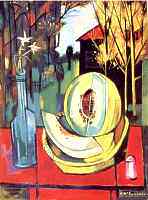 The melon Norah McGuinness |
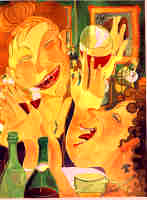 Laughing women Pauline Bewick |
Several Irish women artists responded to the Women's Movement of the 1970s and to the comparative freedom of the post-modernist movement in the arts. Women's experience of life, including pregnancy, childbirth, maternity and family life were now potential subjects for artistic expression as was a female outlook on violence and oppression.
| The Women's Movement has changed the general perception of female experience, investing major aspects of it with a significance and validity previously denied. Aidan Dunne in catalogue of Irish women artists from the eighteenth century to the present day, Dublin, 1987, p.62. |
Irish women artists responded to this and other challenges through a variety of media which included photography, video, computer graphics and installations, as well as traditional media. They include Kathy Prendergast, Dorothy Cross, Louise Walsh, Mary Burke, Cathy Carman, Eithne Jordan, Eilish McCarrick and Jacinta Feeney.